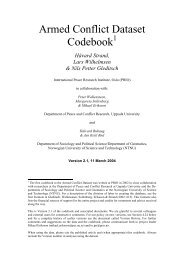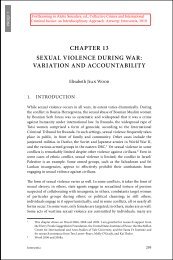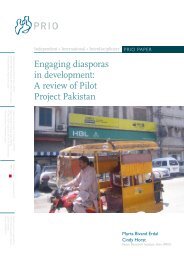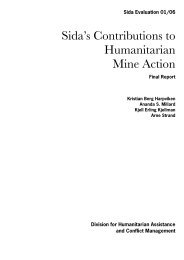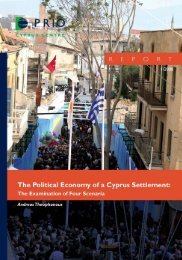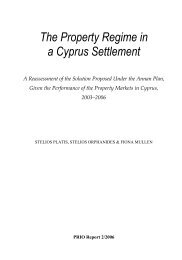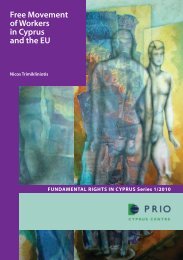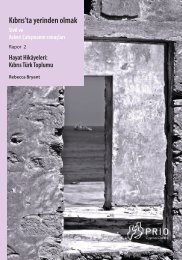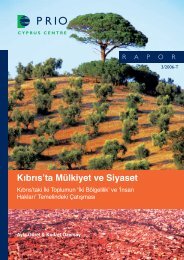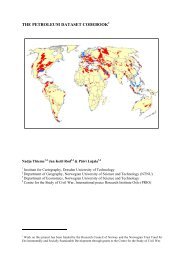Peacemaking Is a Risky Business - PRIO
Peacemaking Is a Risky Business - PRIO
Peacemaking Is a Risky Business - PRIO
You also want an ePaper? Increase the reach of your titles
YUMPU automatically turns print PDFs into web optimized ePapers that Google loves.
210 ‘<strong>Peacemaking</strong> <strong>Is</strong> a <strong>Risky</strong> <strong>Business</strong>’set up, consisting of Uri Savir, Abu Ala and Jan Egeland. In order to strengthen theprogramme and to increase its capacity for implementation, a joint secretariat was establishedin Jerusalem in 1996, headed by Fafo. 283Norway was not the only operator in the peacebuilding market. After 1993, peacebuildingactivities had mushroomed. A range of US organizations placed huge advertisementsin Hebrew and Arabic newspapers, asking for peace- and confidencebuildingpartners. Many European countries did the same. Money was poured into theMiddle East in order to secure this big peace effort. The Palestinians understood thatthey could use the competitive element to secure as much donor money as possible. Ina letter to Jan Egeland, Hanssen-Bauer stressed that Norway was put under ‘mild pressurefrom the parties who are constantly telling us that the Americans and others areready to move in and that they plan to get rid of Norway by dollars’. Hanssen-Bauerbelieved that the P2P programme was important for securing Norway’s high profile inthe peace process. In order to ‘preserve the territory’, Norway should go in with moremoney than the Americans and be an active third party in the planning and implementationof the programme, he recommended. That this was also the only way to secureFafo’s interests is self-evident. 284Negative political developments in the peace process did not favour the P2P concept.Even if the structure of the programme was in place and the main points had beenagreed, the programme did not start up until late autumn 1996, and then on a muchless ambitious scale. By then, the emphasis was on the NGO sector. The P2P programmehad no chance of becoming a political ‘hotline’. Contrary to earlier thinking,the idea by then was that the entire P2P programme should be depoliticized and distancedfrom political developments. This was necessary if any projects were to be implementedat all. Interest in the programme was fading on the Palestinian side. Palestiniansupport of the programme had always been somewhat ambiguous and reluctant.The criticism from the Palestinian side was that the P2P programme was trying tonormalize a basically asymmetric situation. As early as 1997, the Palestinian leadersmade it clear that they were opposed to a relaunch of the programme. The P2P conceptdid not work as a Palestinian peace strategy. 285However, nor did the P2P project work as an <strong>Is</strong>raeli peace strategy. The election ofLikud leader Binyamin Netanyahu in May 1996 definitely produced a changed attitude283 UD 385.32/42, 95/12028-24, Foreign Ministry to Tel Aviv, 21 February 1996; Jan Egeland’sprivate archive, Fafo to Foreign Ministry, 14 February 1996; memorandum of 20 February 1996,Wennesland; Berg 2002, pp. 39–51.284 UD 385.32/42, 95/12028-9, Hanssen-Bauer to Egeland 4 January 1996: ‘Vi blir satt under etmildt press fra partene ved at de stadig forteller oss at amerikanerne og andre står klare til å rykkeinn og at de planlegger å feie Norge av banen med dollar.... Jeg tror det vil være en fordel omNorge bestemmer seg for en pott øremerket til P2P, større enn den halve millionen dollar amerikanernefrister med, men ikke nødvendigvis stor.... Og Norge har et legitimt behov for involveringfor å sikre sine egne investeringer og saksbehandling i forhold til finansiering, og for å “holdereviret”.’; see also Rømming 2003, p. 46–47; Waage 2000b.285 UD 385.32/42, 95/12028-57, Tel Aviv to Foreign Ministry, 11 November 1996; Berg 2002, pp.42–51; Rømming 2003, pp. 47–48.



